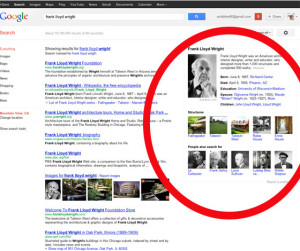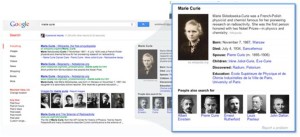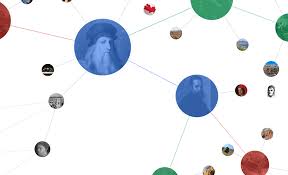Google Knowledge Graph: A Step Towards A More Semantic Web
 Following its mission to provide more and more relevant search results and help its users to find what they’re looking for as quickly as possible, Google has built the Knowledge Graph. Launched in 2012, the Knowledge Graph is a big step towards creating a “semantic web” that understands its human users better and can even engage in conversation with them (almost). The graph is a database of search terms, public figures, landmarks, etc. which aims to create connections between these entries and establish relationships between items in such a way that it almost mimics human understanding of the world.
Following its mission to provide more and more relevant search results and help its users to find what they’re looking for as quickly as possible, Google has built the Knowledge Graph. Launched in 2012, the Knowledge Graph is a big step towards creating a “semantic web” that understands its human users better and can even engage in conversation with them (almost). The graph is a database of search terms, public figures, landmarks, etc. which aims to create connections between these entries and establish relationships between items in such a way that it almost mimics human understanding of the world.
Instead of simply being a small development on the already existing Google index, or just another application of the data already collected, the Knowledge Graph is trying to change the world of the web as we know it. We understand Google as the middleman between us and the website we want to get to, or the source of the information we want. Instead of trying to give us the link to the most relevant website that might answer our question based on our search terms, Google now tries to answer our queries itself on the front page.
When the Knowledge Graph was introduced on Google’s blog in May 2012, the headline read “things, not strings”. That phrase is a great way of explaining how search engines viewed the world before Google Graph and how this could be changing forever. Keywords were all strings of letters to be matched against others string of letters, and similar ones would be returned to the user as a possible answer. Now Google aims to take every search as a “thing” in itself, and return not only the organic search results we are used to, but also enough information about it on the front page that we may not need to go any further. When searching for public figures, the Google Knowledge Graph now returns a picture of the person, some information about their date of birth, height and occupation often pulled from a third party source such as Wikipedia, a list of their works, and related searches that may interest us.
 Knowledge Graph only offers these facts on the front page for search terms it is familiar with and can trace back to its database. For famous people or landmarks, it can easily understand what information you are looking for and provide you with relevant snippets of information before you even get to click on any of the search results. But this is still the beginning, and more ambiguous searches still send the search engine back into its old habits. When searching for a local business for example, you are likely to get a link to an official Google+ page if they have one, or a map with contact details if the business is registered with Google Local.
Knowledge Graph only offers these facts on the front page for search terms it is familiar with and can trace back to its database. For famous people or landmarks, it can easily understand what information you are looking for and provide you with relevant snippets of information before you even get to click on any of the search results. But this is still the beginning, and more ambiguous searches still send the search engine back into its old habits. When searching for a local business for example, you are likely to get a link to an official Google+ page if they have one, or a map with contact details if the business is registered with Google Local.
This could prove to be dangerous when dealing with potential errors. With so many sources for information, it could be any of these parties getting the facts wrong and trying to correct something can prove to be a bit of a headache. Google Knowledge Graph still has a very small support team to answer user queries, and the error reporting system they offer appears to be cumbersome and fruitless. Small businesses may be affected by this more than anyone else, as there’s no information about how long Google will take until they resolve the problem. Users who submit error reports often go without confirmation emails or any sort of acknowledgement from Google, and fixing the problem yourself might be difficult as the source is often untraceable.
A more intelligent search engine requires a better understanding of its users, and Google has come under fire over privacy issues more than once in the past. All these new options to learn more about people’s behaviour online, how they search and what results they prefer over others, may open the door to even more complaints about Google being invasive and storing even more personal data than usual. However, considering these issues were voiced way before Google Knowledge Graph was ever mentioned in conversation, perhaps this is proof that Google is using the data and knowledge of its users’ private preferences to build something constructive rather than playing to the Big Brother stereotype.
 The truth is that Google Knowledge Graph is a big step towards the semantic web that we’ve been dreaming of for years, and will pave the way for more intelligent technology that will understand the world more as we do and less as a set of strings to be compared together. With the product only at the beginning of the journey, some imperfections are inevitable, and some of them can be easily fixed with just a little goodwill from Google. Mistakes could be easily dealt with by allocating more support staff to the project, a lesson Google should have learned from its experiences with Google Local.
The truth is that Google Knowledge Graph is a big step towards the semantic web that we’ve been dreaming of for years, and will pave the way for more intelligent technology that will understand the world more as we do and less as a set of strings to be compared together. With the product only at the beginning of the journey, some imperfections are inevitable, and some of them can be easily fixed with just a little goodwill from Google. Mistakes could be easily dealt with by allocating more support staff to the project, a lesson Google should have learned from its experiences with Google Local.
Small business can help themselves by helping Google and tidying up their online presence in a way that makes it clear to the search engine where they are and what they do. Creating a Google+ page is one of the first steps that should be taken in optimising your company for the Knowledge Graph, as the social network is one of Google’s main ports of call when sourcing information for its search engine results page (SERP). Checking Freebase and Wikipedia entries about your business and correcting them if necessary can also make a world of a difference, as they are both key sources for the Graph. Similarly, Google Local is now an even more important player in getting your services out there, and now is the time to look up your business’ listing on the service and sort out any problems that may appear, such as an outdated phone number or an old logo. It’s better to anticipate the great resource that Google Knowledge Graph is going to grow into rather than simply spend time worrying about the issues it has one year after its launch and doing nothing about it.
